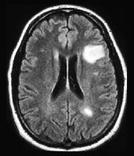Welcome to the Virtual MS Center!
Ask any question you want about Multiple Sclerosis and one of our experts will answer it as soon as possible.
 Here is My Question: Dr. Kinkel, After my son's visit today to discuss his latest MRI results, Dr. Q said "No changes but the old lesions are still there and we need to do all we can to keep him stable." Now is this what they call damage? And this is what causes all of my son's issues right? He has numerous old lesions & the one they found on his right frontal lobe is still there..is there a chance some could go away? Answer: Interpreting MRI scans can be confusing to both patients and neurologists, so let me keep this answer as simple as possible without being misleading. Dr Q was likely referring to the “white spots" on the MRI scan when he/she made the statement, “ No changes but the old lesions are still there…..” Think of these white spots as ancient fossil foot prints left behind by dinosaurs. What you can say about these dinosaur fossils holds true for these "white spots” on MRI: 1. The footprints do not mean there are dinosaurs still present nor do the white spots on MRI mean there is still active MS, although neither excludes the possibility of dinosaurs or active MS. Both represent residual evidence of something that occurred in the past. In fact it is very difficult to tell when the white spots on an MRI occurred if you do not have prior MRI scans that show this area of the brain without the white spots. 2. Once these white spots on the MRI are present for several months they do not go away, much like the dinosaur footprints. MS related white spots often get smaller in the months following their formation but it is uncommon for them to completely disappear. This is in contrast to some other diseases where the white spots often do disappear. 3. The underlying brain tissue seen as a white spot on MRI may be functioning almost normally or nearly destroyed. The MRI sequence used to detect the white spot is not able to determine the structural integrity or function of the tissue. Similarly, the ground underneath the dinosaur footprint may be normal (just compressed) or destroyed. Therefore, when you are told that the white spots on an MRI look the same with nothing new, this is a good thing but not the only thing. You also want to know if other features of the MRI suggest ongoing disease activity that may be producing further damage. Some of these other MRI features can be inferred from other imaging sequences (not the sequences that show the white spots) but most require research MRI techniques. In practice our main goal is to make sure that there are no new white spots appearing after we start a treatment for MS. This is one of our main initial goals of therapy. Rip Kinkel, MD
Susan Sheehan
5/27/2014 08:23:12 am
Thanks Dr. K. Best explanation I've heard in a long time
Carole Marra
5/27/2014 09:46:21 am
Thank you for explaining this so that I can get a better understanding,very much appreciated! Comments are closed.
|
PLEASE NOTE: This information/opinions on this site should be used as an information source only. This information does not create any patient-HCP relationship, and should not be used as a substitute for professional diagnosis and treatment. Please consult your health care provider before making any healthcare decisions or for guidance about a specific medical condition.
Archives
June 2024
Categories
All
|